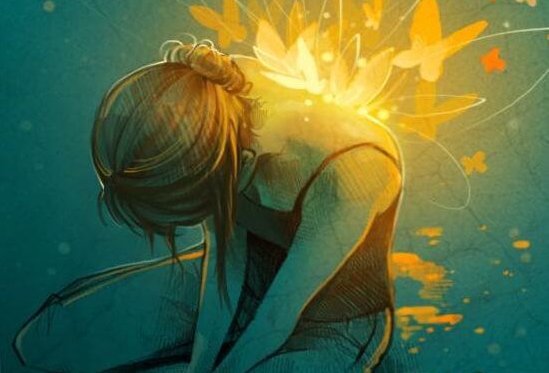Constructive Pain: The Kind that Teaches and Connects People


Written and verified by the psychologist Valeria Sabater
Dante said that a person who knows pain knows everything. But does that mean we’re forced to suffer if we want to really understand life? Not exactly.
The first thing to keep in mind is that pain comes from your brain. After getting certain signals from your environment, body, and senses, your brain interprets them and instantly decides whether to produce a feeling of pain. It’s like a panic button is pressed when you feel someone or something threatening your physical or emotional well-being.
But here comes the most interesting part: every pain signal you feel and perceive has a purpose. We call it constructive pain for a reason. It’s a warning sign, so you shouldn’t ignore it. When you put your hand in a fire, your brain will send you a signal of intense pain. But when you take it out, your brain will instantly send a variety of chemicals to alleviate the feeling of pain.
In fact, almost the exact same thing happens on the emotional level. When you undergo trauma, your brain will interpret it almost like an actual burn. Pain demands a reaction. To act, to pull our hand from the fire. And the lesson we learn from it — it’s one we never forget.
Constructive pain and happiness
It was Aldous Huxley who showed us how living in a state of endless pleasure can lead to truly dystopian societies. You can see it for yourself in his novel, “Brave New World.” Though the idea of endless pleasure seems great, the reality is usually very different. In a certain sense, we could almost say that human beings need a bit of pain as a contrast to pleasure.
For example, there aren’t many things as comforting as coming home after a cold winter day and drinking hot chocolate. And athletes also feel euphoria after intense physical exertion. During that exertion, endorphins and other endogenous opiates come together to soothe the pain of the physical effort.
So if we say that pain can actually increase your feeling of pleasure and happiness, it’s not a contradiction. There are a lot of studies on the topic, like this one in “Personality and Social Psychology Review.” They explain how suffering, short-lived and properly processed, gives us a feeling of pleasure and keeps us connected to the world around us.

For example, think of times in your life when you’ve been strong. Times when you had no other option than to be brave. It might have been an illness, a loss, or maybe the worst disappointment of your life.
Overcoming the hard part of that internal, occasionally heartbreaking journey strengthened your psychological muscles. Thanks to your inner strength, you now feel freer and better equipped to create and enjoy your own happiness.
Constructive pain: managing it and ending it
At the beginning we talked about how emotional suffering is interpreted by our brain like a real burn. That’s not our own idea though, or just a metaphor. In fact it was proven in a study published in “Proceedings of the National Academy of Sciences.”
Neuroscience tells us that when someone says something like, “the pain is in your head,” they’re not wrong. It’s real because there’s a very complex structure, the anterior cingulate cortex, that doesn’t distinguish between physical and mental pain. It’s all the same to this part of your brain. And that’s why emotional pain can be so devastating.
But if suffering is in our heads and ruled by our brains, can we “turn it off?” The first thing most people think of are pills. Well, remember that neither painkillers or antidepressants are the answer. All they do is dull the pain in the cingulate cortex, but they’ll never fix the underlying emotional problem.
Pain, don’t forget, is a cry for attention. It’s like a lighthouse on the shore warning you there’s a reef ahead so you don’t crash into it. If you decide to hide in the hold like a stowaway, you won’t be solving the problem. The reef will still be there.
So the only option is to change directions, raise your sails, and grab the rudder of your life. Then you can look for calmer seas, more favorable currents, and more hopeful winds.
Dante said that a person who knows pain knows everything. But does that mean we’re forced to suffer if we want to really understand life? Not exactly.
The first thing to keep in mind is that pain comes from your brain. After getting certain signals from your environment, body, and senses, your brain interprets them and instantly decides whether to produce a feeling of pain. It’s like a panic button is pressed when you feel someone or something threatening your physical or emotional well-being.
But here comes the most interesting part: every pain signal you feel and perceive has a purpose. We call it constructive pain for a reason. It’s a warning sign, so you shouldn’t ignore it. When you put your hand in a fire, your brain will send you a signal of intense pain. But when you take it out, your brain will instantly send a variety of chemicals to alleviate the feeling of pain.
In fact, almost the exact same thing happens on the emotional level. When you undergo trauma, your brain will interpret it almost like an actual burn. Pain demands a reaction. To act, to pull our hand from the fire. And the lesson we learn from it — it’s one we never forget.
Constructive pain and happiness
It was Aldous Huxley who showed us how living in a state of endless pleasure can lead to truly dystopian societies. You can see it for yourself in his novel, “Brave New World.” Though the idea of endless pleasure seems great, the reality is usually very different. In a certain sense, we could almost say that human beings need a bit of pain as a contrast to pleasure.
For example, there aren’t many things as comforting as coming home after a cold winter day and drinking hot chocolate. And athletes also feel euphoria after intense physical exertion. During that exertion, endorphins and other endogenous opiates come together to soothe the pain of the physical effort.
So if we say that pain can actually increase your feeling of pleasure and happiness, it’s not a contradiction. There are a lot of studies on the topic, like this one in “Personality and Social Psychology Review.” They explain how suffering, short-lived and properly processed, gives us a feeling of pleasure and keeps us connected to the world around us.

For example, think of times in your life when you’ve been strong. Times when you had no other option than to be brave. It might have been an illness, a loss, or maybe the worst disappointment of your life.
Overcoming the hard part of that internal, occasionally heartbreaking journey strengthened your psychological muscles. Thanks to your inner strength, you now feel freer and better equipped to create and enjoy your own happiness.
Constructive pain: managing it and ending it
At the beginning we talked about how emotional suffering is interpreted by our brain like a real burn. That’s not our own idea though, or just a metaphor. In fact it was proven in a study published in “Proceedings of the National Academy of Sciences.”
Neuroscience tells us that when someone says something like, “the pain is in your head,” they’re not wrong. It’s real because there’s a very complex structure, the anterior cingulate cortex, that doesn’t distinguish between physical and mental pain. It’s all the same to this part of your brain. And that’s why emotional pain can be so devastating.
But if suffering is in our heads and ruled by our brains, can we “turn it off?” The first thing most people think of are pills. Well, remember that neither painkillers or antidepressants are the answer. All they do is dull the pain in the cingulate cortex, but they’ll never fix the underlying emotional problem.
Pain, don’t forget, is a cry for attention. It’s like a lighthouse on the shore warning you there’s a reef ahead so you don’t crash into it. If you decide to hide in the hold like a stowaway, you won’t be solving the problem. The reef will still be there.
So the only option is to change directions, raise your sails, and grab the rudder of your life. Then you can look for calmer seas, more favorable currents, and more hopeful winds.
This text is provided for informational purposes only and does not replace consultation with a professional. If in doubt, consult your specialist.







